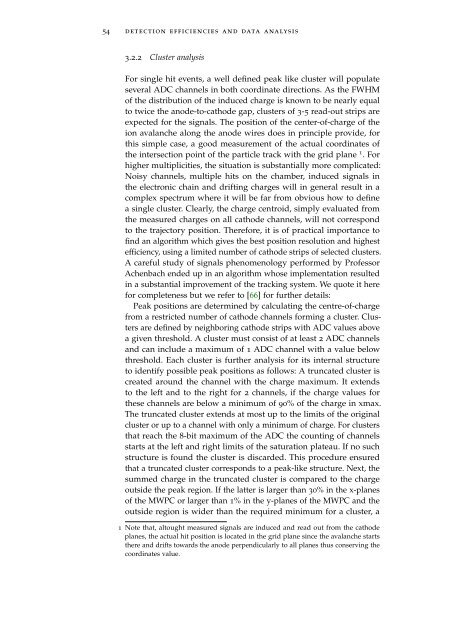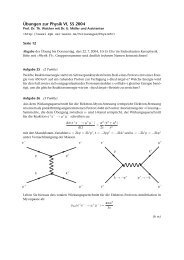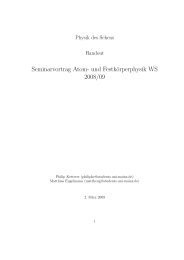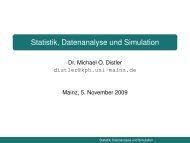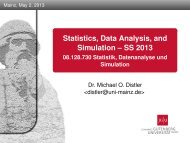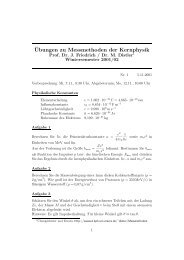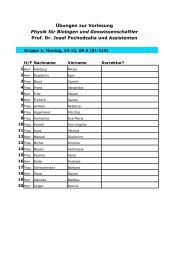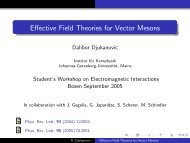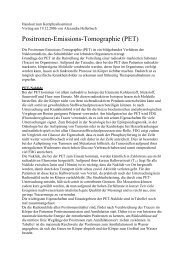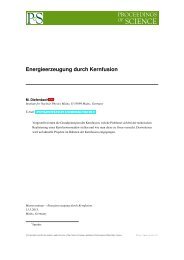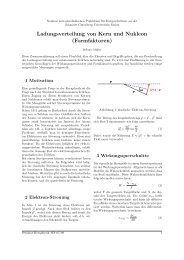A Classic Thesis Style - Johannes Gutenberg-Universität Mainz
A Classic Thesis Style - Johannes Gutenberg-Universität Mainz
A Classic Thesis Style - Johannes Gutenberg-Universität Mainz
You also want an ePaper? Increase the reach of your titles
YUMPU automatically turns print PDFs into web optimized ePapers that Google loves.
54 detection efficiencies and data analysis<br />
3.2.2 Cluster analysis<br />
For single hit events, a well defined peak like cluster will populate<br />
several ADC channels in both coordinate directions. As the FWHM<br />
of the distribution of the induced charge is known to be nearly equal<br />
to twice the anode-to-cathode gap, clusters of 3-5 read-out strips are<br />
expected for the signals. The position of the center-of-charge of the<br />
ion avalanche along the anode wires does in principle provide, for<br />
this simple case, a good measurement of the actual coordinates of<br />
the intersection point of the particle track with the grid plane 1 . For<br />
higher multiplicities, the situation is substantially more complicated:<br />
Noisy channels, multiple hits on the chamber, induced signals in<br />
the electronic chain and drifting charges will in general result in a<br />
complex spectrum where it will be far from obvious how to define<br />
a single cluster. Clearly, the charge centroid, simply evaluated from<br />
the measured charges on all cathode channels, will not correspond<br />
to the trajectory position. Therefore, it is of practical importance to<br />
find an algorithm which gives the best position resolution and highest<br />
efficiency, using a limited number of cathode strips of selected clusters.<br />
A careful study of signals phenomenology performed by Professor<br />
Achenbach ended up in an algorithm whose implementation resulted<br />
in a substantial improvement of the tracking system. We quote it here<br />
for completeness but we refer to [66] for further details:<br />
Peak positions are determined by calculating the centre-of-charge<br />
from a restricted number of cathode channels forming a cluster. Clusters<br />
are defined by neighboring cathode strips with ADC values above<br />
a given threshold. A cluster must consist of at least 2 ADC channels<br />
and can include a maximum of 1 ADC channel with a value below<br />
threshold. Each cluster is further analysis for its internal structure<br />
to identify possible peak positions as follows: A truncated cluster is<br />
created around the channel with the charge maximum. It extends<br />
to the left and to the right for 2 channels, if the charge values for<br />
these channels are below a minimum of 90% of the charge in xmax.<br />
The truncated cluster extends at most up to the limits of the original<br />
cluster or up to a channel with only a minimum of charge. For clusters<br />
that reach the 8-bit maximum of the ADC the counting of channels<br />
starts at the left and right limits of the saturation plateau. If no such<br />
structure is found the cluster is discarded. This procedure ensured<br />
that a truncated cluster corresponds to a peak-like structure. Next, the<br />
summed charge in the truncated cluster is compared to the charge<br />
outside the peak region. If the latter is larger than 30% in the x-planes<br />
of the MWPC or larger than 1% in the y-planes of the MWPC and the<br />
outside region is wider than the required minimum for a cluster, a<br />
1 Note that, altought measured signals are induced and read out from the cathode<br />
planes, the actual hit position is located in the grid plane since the avalanche starts<br />
there and drifts towards the anode perpendicularly to all planes thus conserving the<br />
coordinates value.


